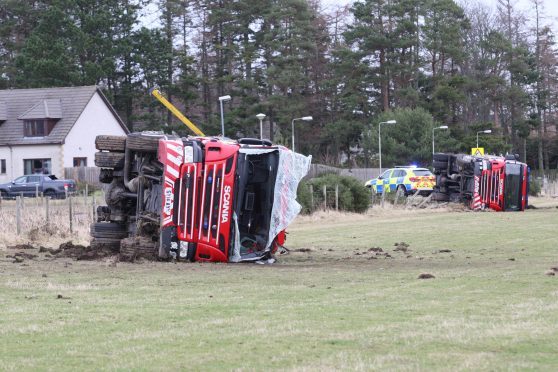Two fire engines were going too fast when they skidded on black ice and went out of control on the outskirts of the Highland capital.
Investigators have found the appliances were travelling “in excess” of guideline speeds before crashing and overturning in a field at Culloden.
And a probe has also revealed that three of the firefighters were not wearing seatbelts.
The dramatic incident – which happened while the service responded to an early morning emergency in February – left nine firefighters injured.
The Press and Journal can today reveal that an investigation by the Scottish Fire and Rescue Service (SFRS) confirmed that the drivers of both engines “lost control of their vehicles due to skidding on black ice” on the B9006 Inverness-Fort George road.
But the inquiry also found that the emergency response speeds for both £260,000 appliances “were in excess of SFRS guidance for this type of road”.
Three of the crew members were not wearing seatbelts at the time, according to the report, and two were wearing helmets.
Fire chiefs last night vowed to act on the report recommendations, including reviewing driver training in bad weather, and the way the service gathers and shares information on weather conditions.
Three appliances were called out at 7.06am on February 6 to a report of a crash in which people had been trapped.
While travelling on the B9006 at 7.14am, the first engine skidded on black ice, spun 180 degrees on the road and hit the raised grass verge, before rotating 360 degrees and landing in a field.
Having seen the incident, the driver of second engine slowed – but it too began to skid and also left the road and overturned in the field.
Nine crew members sustained injuries, ranging from cuts and bruises to spleen damage and fractures, with five requiring treatment at Raigmore Hospital.
The Fleet Transport Association inspected the vehicles and found there were “no safety related issues that contributed to the incident”.
The Press and Journal reported at the time that Highland Council gritters had been just minutes away from treating that section of the road.
Speed limits do not apply to fire engines on emergency calls and it is not known how fast they were going, although they left the road at a section where a 40mph restriction ends.
Investigators concluded that the “immediate cause” of the crash was the appliances “skidding on a section of black ice”.
They noted that weather warnings received by the SFRS do not include road surface temperatures, and added that there were “limited arrangements” in place for vehicle familiarisation training, particularly the setting of adjustable retarders in slippery conditions.
Lewis Ramsay, SFRS assistant chief officer and director of response and resilience, said: “This incident is a powerful reminder of the risks faced by frontline crews and it shows how even highly experienced emergency response drivers in state-of-the-art vehicles can be affected by inclement road and weather conditions.”
He added: “The investigation established that the immediate cause of the crash was the two vehicles skidding on black ice.
“As a result, we are reviewing arrangements for gathering information on road conditions and how these may present specific route risks, in order to ensure that our crews are advised accordingly.
“We are also reviewing training in relation to driving in inclement weather and driver familiarisation with specific vehicles, although the investigation did not find this to be a contributory factor in the crash.”
Highland Conservative MSP Douglas Ross said: “There’s no doubt in an emergency the public expect the fire service and other to get to them as quickly and as safely as possible.
“However, it’s clear that perhaps there could be closer working, for example, with the local authority who have information on road temperatures for gritting, to ensure the potential for accidents like this is reduced.”
Culloden Community Council chairman David McGrath said: “It’s the gritting that is the problem. It was a very expensive error of judgment by somebody but I don’t think you can blame the fire brigade.”
